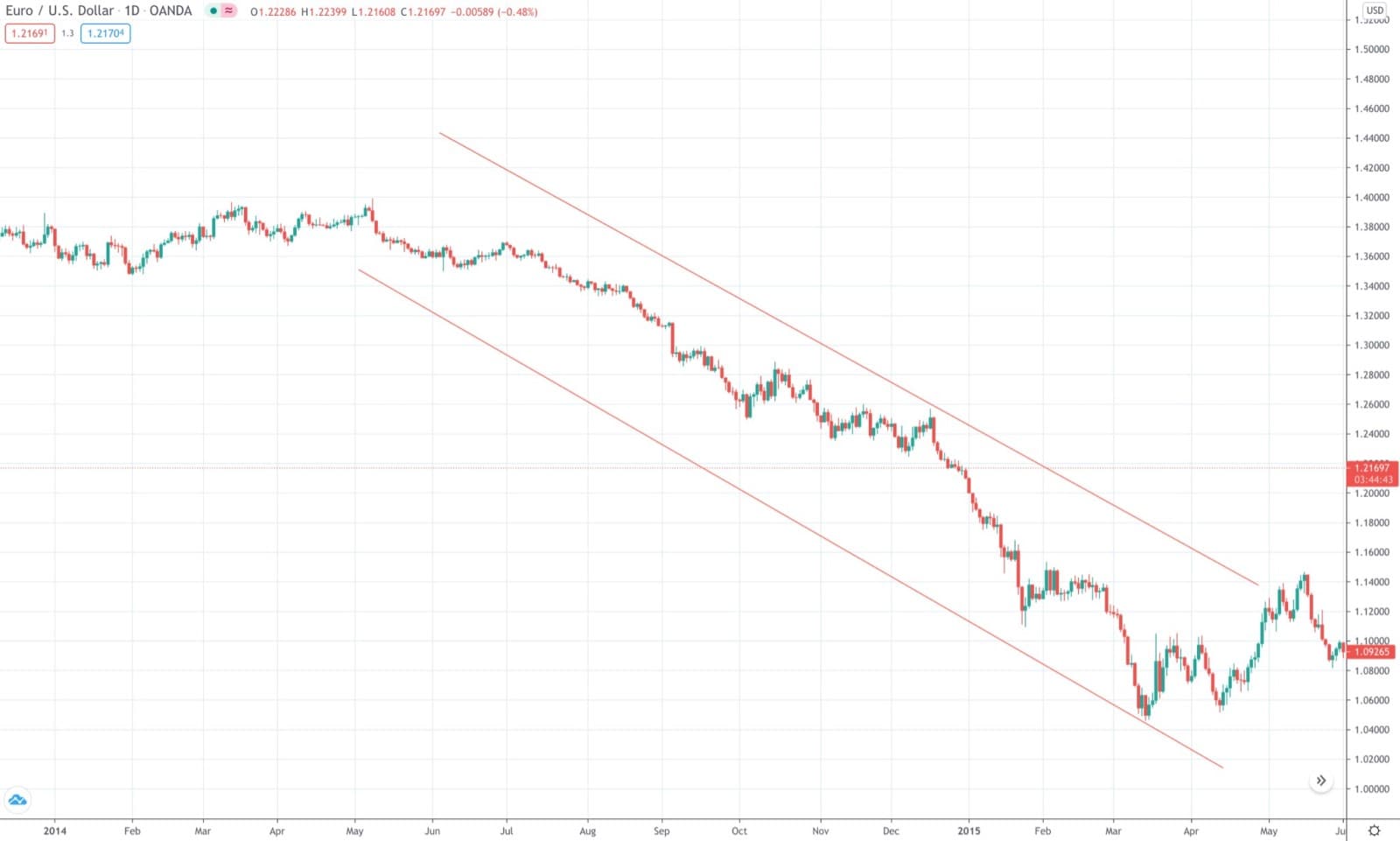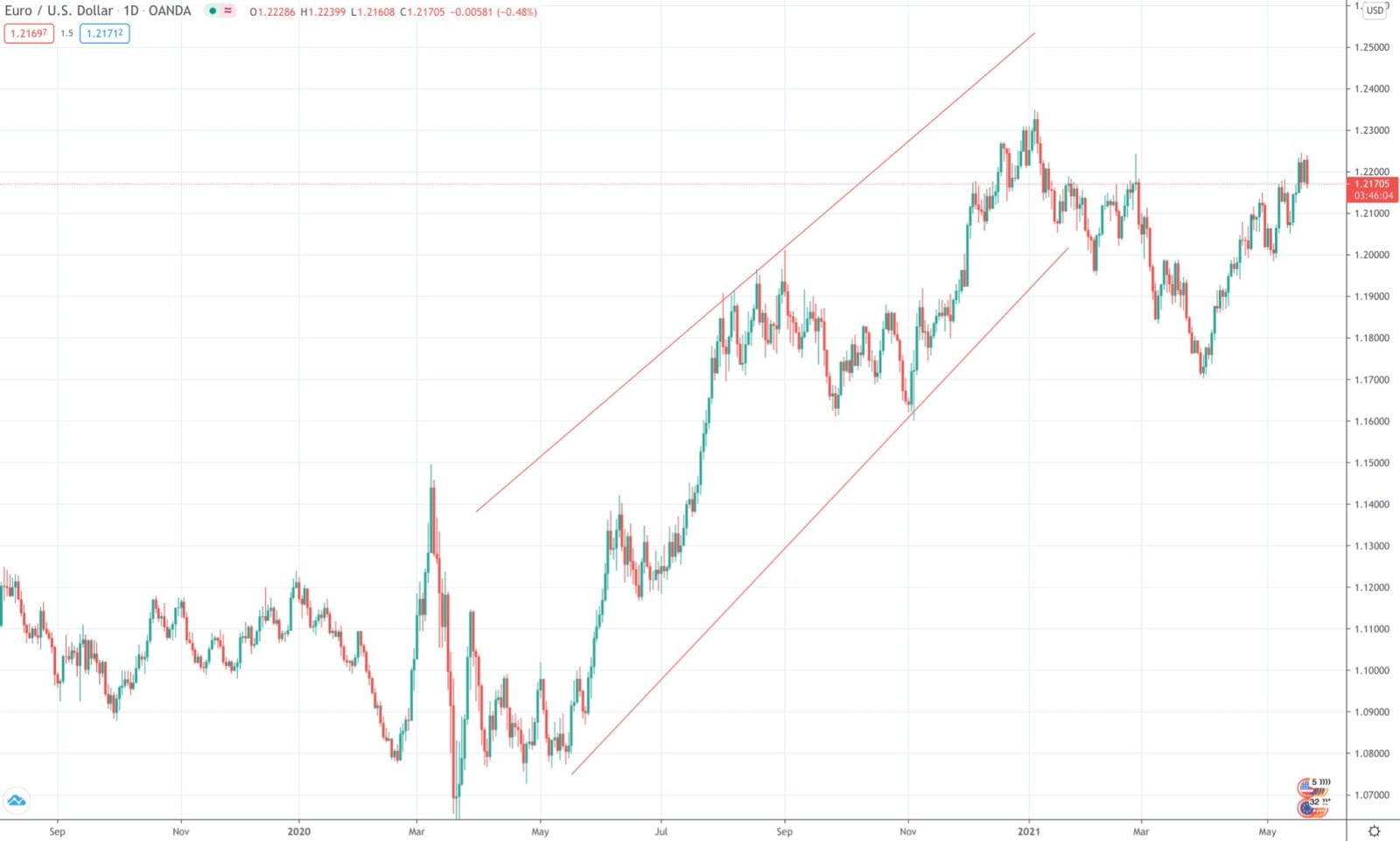

Bullish vs Bearish Markets: How to Distinguish Them
Bearish: What It Means in Trading
Unsurprisingly, the term bearish comes from the word 'bear'. So, let's dive in to find out what it means for traders.
A bear is a trader that believes the market will move downward. As such, they open a sell or so-called short position. Why a bear? As the price of the asset declines, there's an association that bears pull the price down with their paws. Also, it's believed that the term was created around the 18th century, when there was a proverb, "don't sell the bear's skin before catching the bear".
The term bearish can be applied both to a trader and a market. So, you can see the phrase that they are bearish, which means the trader believes the price will fall.
A bearish market reflects when the price drops by at least 20% from recent highs. The period of the fall depends on the timeframe being looked at. The price should go down for at least a month on the daily chart. If we look at the 5-minute timeframe, the assets should slide for at least a day.
A bearish market reflects when the price drops by at least 20% from recent highs.
However, these rules are approximate. When you look at the price chart, you'll easily understand whether the market is bearish.
On the daily chart of the EUR/USD pair, you can see the price was down for a year. It's a real bearish market.

Bearish also relates to the market trend. You may hear that a trend is bearish or there's a downtrend. That means that the price goes down for a long period.
Bullish: What It Means in Trading
On the other side of the spectrum, bullish refers to bulls, the opposite of a bear. There's no etymological reference to the creation of the term 'bull'. More likely, it was used as an opposition to the bear. Bulls think the market conditions are favourable for the asset's appreciation. That's why they push the price up with their horns.
Bullish also relates to both a trader and a market. Traders are bullish when they open long positions as their fundamental or technical analysis signals an upward price movement.
The market can be considered bullish if the price surges by at least 20% from recent lows. Also, the price should rise for some time. Similar to the bear market, we can't define a certain period. However, you'll understand whether the market is bullish by looking at the chart.
The market can be considered bullish if the price surges by at least 20% from recent lows.
On the daily chart of EUR/USD, you can see an uptrend going strong for 7 months.

There's a bullish trend or uptrend as well. It shows that the price appreciates for the long term.
Bullish vs Bearish Markets: Characteristics
Let's compare bullish vs bearish markets.
|
Bullish |
Bearish |
|
|
Market Behaviour |
The price increases |
The price declines |
|
Supply and Demand |
When the market is bullish, it means the demand exceeds the supply. Thus, many investors want to buy an asset and are ready to pay any price to get it. But few investors can offer this security for short-selling. |
In a bearish market, more investors want to sell an asset, and fewer want to buy it. Thus, the price goes down. |
|
Investor Behaviour |
In the bull market, traders are optimistic due to positive factors that boost the asset's price. |
Although the bear market is potentially profitable for traders, the investor sentiment is negative, making them sell the asset. |
|
Factors |
A bull market is supported by positive reading for assets. For instance, releases that define economic growth push a domestic currency up. Positive earnings lead to an appreciation of the company's stocks. |
With a wide range of securities, a large list of factors can cause bear market conditions. The bear market always relates to something weak. It can be a weak economy that affects currencies, weak earnings that impact shares, etc. |
|
Investor/Trader Opportunities |
A bullish market is positive for both traders and investors. A trader can enter the market and close the position when the price increases in value. An investor, who holds a security, earns on the price surge. |
If you're a trader, you can buy or sell an asset without owning it. If you're an investor, you can sell the asset only if you own it. |
Bullish and bearish markets are opposites. Still, if you're a trader, you can find opportunities in both of them. Opening one trade in a bull market, you hedge your funds entering a bearish one.
How to Determine Market Trend Types
The bearish and bullish terms also relate to market trends. You can hear that the trend is bearish or bullish. It means that the price either goes down or up for a long period.
To define whether the market is bullish or bearish, you can look at the chart and see the rate direction. If the asset goes up, the market is bullish. If the price declines, the market is bearish.
However, not all ups and downs reflect bull or bear run. The market should move in the same direction for the long term, and it differs for each timeframe.
It's vital to understand that the market can't always move in the same direction. There are falls even within a bullish trend and jumps when the market is considered bearish. It's just corrections that can happen due to unexpected news, demand/supply inequality, etc.
It's vital to understand that the market can't always move in the same direction. There are falls within the bullish trend and jumps when the market is considered bearish. It's just market corrections.
There are also conditions when the market is neither bullish nor bearish. It's a period of correction or sideways movements when neither bulls nor bears can take control of the market.
If you need to define the market sentiment going forward, you can use fundamental and technical analysis that will determine (not 100% accurately but with a high degree of confidence) where the price will go.
What Investors and Traders Do in a Bullish Market: Top Strategies
We are sure you know that investor and trader behaviour varies as the underlying concepts of their activity are different.
Investing is an opportunity to take advantage of security's appreciation with subsequent selling when the price is high enough. Also, investors can get additional payments for holding the assets, such as with stock dividends.
Trading is more speculative. However, some people find trading more appealing than investing since it relies on numbers-based analysis rather than holistic fundamental analysis. Traders open a long position to close it when the price reaches a certain forecasted level.
Strategy #1: Buy When the Price Appreciates
In the bull market, the price increases. The main strategy for both investors and traders' strategy is to buy the asset at the lowest price to gain as much as possible.
It's not easy to enter the market at lows as there's no confidence the market will turn bullish. That's why traders and investors use fundamental and technical analysis.
A trader should close the position when the price is high enough. Investors can sell the asset when the price reaches a suitable rate for them.
Strategy #2: Increase a Successful Trade
Besides the common strategy of opening a long position and closing it at a certain level, traders can add funds while the trade is open. But please note that trading can be risky and can lead to losing all of your invested capital.
If you see the market keeps rising, you can add funds and increase your trade.
What Investors and Traders Do in a Bearish Market? Top Strategies
The bear market is even more different for investors and traders than the bullish one. If the market is bearish, the asset an investor owns depreciates. It's a loss for them.
Meanwhile, traders have an opportunity to succeed even when the price goes down as they don't own the asset but only speculate on the price difference.
Strategy #1: Sell When the Price Depreciates
If you're a trader and predict the price will decline, you can open a short position, set the level the price is supposed to reach, and potentially earn if your projection is correct. You should define the price fall in these circumstances as soon as possible.
If you're an investor, you should hurry to sell your asset before the price plunges.
Strategy #2: Add Your Funds
The second strategy for the bear trader is to add funds if the short trade is profitable. It's possible to add money to increase the position size and replace the Take-Profit order to allow your trade to stay open for longer.
Conclusion. Bullish vs Bearish: What Market to Trade
Let's summarise. Bullish and bearish markets are opposite as they reflect different price directions. In a bull market, the price surges. In a bear market, it declines.
A bull market provides opportunities for traders and investors. In contrast, a bear market is positive only for traders who don't own assets and trade on the price difference.
The major pitfall for traders is to define whether bulls or bears prevail in the market. To gain experience, you can open a Libertex demo account, which resembles the real one but allows you to practise with virtual funds, i.e., without risking real money.
It's time to structure all the information provided.
FAQ
How Do You Know If a Market Is Bullish or Bearish?
If the price goes up by at least 20% from recent lows for a certain period, the market is bullish. If the price slides by at least 20% from recent highs for a long period, it's a sign of a bear market.
Is Bullish Good or Bad?
A bullish market is neither good nor bad. It's just precise trading conditions that occur when the price goes up. So, traders can open a long position.
Is Bearish Good or Bad?
Despite a common misconception among beginner traders, a bearish market provides the same level of opportunities as a bullish market if you trade, not invest. Trading is available for buying and shorting.
What Is the Longest Bull Market in History?
The longest bull run in history happened to the S&P 500 index from March 2009 until March 2020. The stock market and stock indices are most susceptible to long-term trends.
What Is the Longest Bear Market in History?
The longest bearish run prevailed in the market for 31 months, beginning in 2000 after the dot-com bubble popped.
Is It Good to Buy Bearish Stocks?
It's good to buy bearish stocks when a trend reversal is expected. You get an opportunity to buy the shares at a low price and potentially gain profit when the rate surges.
Is It Better to Buy Bullish or Bearish?
A trader should buy when the market is bullish. It's vital to catch the moment when the price is at the lowest levels of the upcoming bullish trend. If the market is bearish, wait for the price reversal and open long trade.
What Are the Best Stocks to Buy in a Bear Market?
There are no best stocks to buy in a bear market. If the market is bearish, you can wait for a reversal signal and buy stocks that declined to an affordable rate.
Why Is It Called Bullish & Bearish?
Bullish relates to a market in which the price rises, or traders project the price will increase, so they buy an asset. The market is bearish when prices decline. A bearish trader opens a sell trade.
Disclaimer: The information in this article is not intended to be and does not constitute investment advice or any other form of advice or recommendation of any sort offered or endorsed by Libertex. Past performance does not guarantee future results.
Why trade with Libertex?
- Get access to a free demo account free of charge.
- Enjoy technical support from an operator 5 days a week, from 9 a.m. to 9 p.m. (Central European Standard Time).
- Use a multiplier of up to 1:30 (for retail clients).
- Operate on a platform for any device: Libertex and MetaTrader.